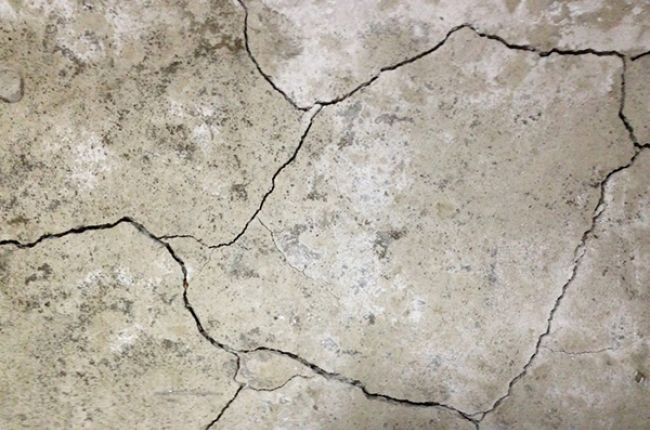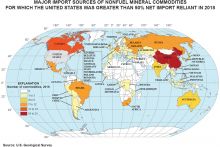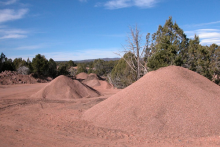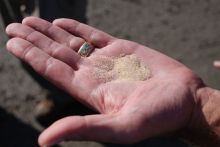
Pyrite and pyrrhotite are minerals known as iron sulfides. When iron sulfides are exposed to water and oxygen, a series of chemical reactions breaks down the iron sulfides and forms new minerals called sulfates. These sulfates take up more space than the original iron sulfides. As they grow, the new sulfate minerals push against the surrounding rock, causing it to swell and crack. This causes damage in two main ways:
- If pyrite or pyrrhotite are present in the rocks underneath buildings, the swelling can push on the foundation, walls, and basement floor of the building, causing cracks and other structural damage. In some cases, groundwater can then transport sulfates into the cracked foundation, causing further damage.
- If pyrite or pyrrhotite are present in the aggregate material used to make concrete, the building material itself can be compromised. If water and air get into the concrete through small cracks and holes, the iron sulfides inside can begin to break down, cracking the concrete and allowing more air and water in, causing even more damage. This is a particular problem for concrete foundations and basements when water seeps in from the surrounding ground.
Pyrite in underlying rocks
Pyrite is a common mineral in shale, coalbeds, and adjacent rocks. However, rocks containing pyrite generally don’t cause swelling problems unless they are disturbed by human activity. Excavations and other ground disturbance during construction projects can break up the underlying rock, allowing water and air (and therefore oxygen) to get into the rock and begin the reactions that cause swelling, which can continue for many years after the construction is finished.
Pyrite and pyrrhotite in aggregates and concrete
Aggregates, such as sand, gravel, crushed stone, or other rocky material, are used as fill material in construction and are added to cement and water to make concrete. Aggregates come from a wide variety of sources, and sometimes the source rocks may contain pyrite or pyrrhotite. Problems can arise if these aggregates are used to make concrete or as fill material beneath or around building foundations. If used to make concrete foundations, the foundations themselves can swell and crumble. If used as fill material, which is loose and porous, water and air can easily get in, causing swelling in the fill material, which damages the surrounding foundations.
Incidence and solutions
Structural damage to buildings due to pyrite or pyrrhotite breakdown has been observed in many places around the world since the mid-1950s, including Ireland, Wales, Spain, Canada, Namibia, and Japan. In the United States, pyrite-induced swelling has been observed in Ohio, West Virginia, Pennsylvania, Missouri, Kansas, and Kentucky, and more recently thousands of homes in Connecticut have been affected by pyrrhotite in concrete foundations.
Pyrite/pyrrhotite breakdown is just one of many ways in which buildings can be affected by physical or chemical processes in construction materials or underlying rock. Geotechnical engineers and engineering geologists identify potential problem areas and devise solutions to reduce the incidence of these and other damages.
Learn More:
- Expansion of Pyritic Shales (Article), National Research Council Canada
1972 article explaining the cause, effects, and some examples of pyrite-induced swelling (some technical language)
- Concrete Foundations: Information and Quick Facts (PDF), Connecticut Department of Consumer Protection
Basic information for homeowners on how to respond to damaged concrete foundations in Connecticut, including relevant contact information
- About Concrete Foundations and our Investigation (Webpage), Connecticut Department of Consumer Protection
Details of Connecticut's investigation into deteriorating concrete foundations in Connecticut caused by pyrrhotite in aggregates used for concrete - includes information on technical investigations, legislation, insurance issues, and resources for homeowners
- Evolution of pyrrhotite oxidation in aggregates for concrete (Technical Article), Materiales de Construcción
2014 article with extensive technical detail on how pyrrhotite causes damage to concrete, including a number of real-world examples




